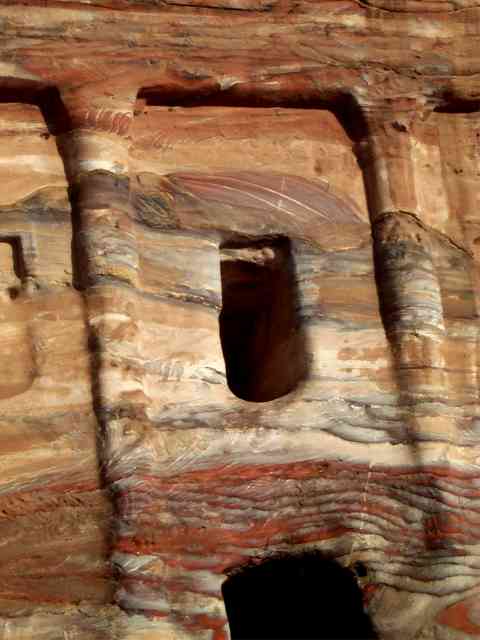![]()
The Nabataean city of Petra
|
|
The Nabataean city of Petra |

Petra, a riot of colours carved out of the rocks
| Petra |
| On average, there might be a
thousand visitors a day visiting Petra. And everyone who has read Tintin
will remember the famous sight of the group approaching the Treasury
through a narrow pass to meet with Abdullah's father. We have seen quite a
few wonders of the world during this trip but nothing could quite prepare
us for the colours of Petra. Seeing is believing ! One enters the city
through a 1.2 km "Siq" : a long and narrow passage. The Siq often narrows to about 5 meters (at some points to about
2 m) and the walls can tower up to 200 meters overhead. The Siq is not a
canyon (carved out by water) but is one block that was ripped apart by
tectonic forces. This narrow passage, the Bedouins and their ancestors,
the Nabataeans, protected the secret of Petra for many centuries until it
was rediscovered in the early 19th century.
|
|
|
|
The long and narrow Siq leading us to a first glimpse of Petra's majestic treasury
|
|
The city of Petra became the sophisticated capital of the Nabataean empire after the passage of Alexander the Great in 312 BC. As their territory expanded, more caravan routes came under their control and their wealth increased accordingly. What the Nabataeans built is a fantastic city mostly carved out of rock. There are 800 registered sites in Petra of which 500 tombs. When the Romans finally defeated the local Nabataeans, they went around adding their own temples, baths and roads some of which still remain.
|
|
|
|
Erosion from wind, water and salt has taken its toll and worn out the carved structures. This leaves us with strange but beautiful shapes.
|
| "Much of Petra's
fascination comes from its setting on the edge of Wadi Araba. The sheer
and rugged sandstone hills form a deep canyon... Few buildings in Petra
(which means rock in Greek) are freestanding : the bulk are cut into the
rock" (LP) What struck us most and will remain with us is the sheer
variety of colours. Everywhere we looked, rocks had different colour
ranging from shades of red to pink and yellow, from shades of grey to
white and even blue. These colours form waves that have seen the light as
the Nabataeans carved out through the history of the stone. These were
real, natural works of art. Here's a small selection !
|
|
|
|
|
|
|
|
The local piece of craftsmanship to buy is the sand bottle : for one of the sellers it was happy hour ! Taxi ! (centre) The Monastery (right)
|
|
|
|
There is life in the desert. The different shades of green came out very strongly against the mostly brick colours of the environment
|
|
|
|
A thing of beauty is a joy forever
|
We are doing well !
| Mosaics and biblical Jordan (heavy files) | Back to Trip page | The red jebels of Wadi Rum |